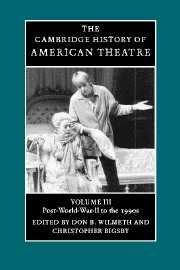Book contents
- Frontmatter
- Introduction
- Timeline: Post-World War II to 1998
- 1 American Theatre in Context: 1945–Present
- 2 A Changing Theatre: Broadway to the Regions
- 3 The Plays and Playwrights
- 4 Musical Theatre since World War II
- 5 Directors and Direction
- 6 Actors and Acting
- 7 American Theatre Design Since 1945
- Bibliography
- Index
2 - A Changing Theatre: Broadway to the Regions
Published online by Cambridge University Press: 28 March 2008
- Frontmatter
- Introduction
- Timeline: Post-World War II to 1998
- 1 American Theatre in Context: 1945–Present
- 2 A Changing Theatre: Broadway to the Regions
- 3 The Plays and Playwrights
- 4 Musical Theatre since World War II
- 5 Directors and Direction
- 6 Actors and Acting
- 7 American Theatre Design Since 1945
- Bibliography
- Index
Summary
Introduction
The object that stands outside the circle usually casts the longest shadow across it. To understand the ever increasingly complicated world of Broadway in the last half of this century, one only has to look at a single event on the evening – midnight to be exact – of 6 April 1947 when, at the Waldorf Astoria, the American Theatre Wing paid tribute to its former executive director, Antoinette Perry, who had died the previous year. The tribute came in the form of awards given for achievements on Broadway in that current season – and they would be called, in respect for Ms. Perry, the Tony Awards.
The evening was a casual affair, by contemporary standards. There were no ranks of nominees from which a winner suspensefully emerged; there were no “bests” – just outstanding achievements; there was some brief entertainment courtesy of several musicals then running, plus performers such as Frank Fay, Ethel Waters, and newcomer David Wayne; the list of awards was broadcast at midnight for fifteen minutes on a local radio station.
What was significant that night is that despite the almost coyly modest affair, the Tony Awards – and the larger enterprise they became – were Broadway’s first attempt to model itself after another entertainment industry – the movies – and eventually by the fifties, the selection and presentation of the awards mirrored those of the Academy of Motion Picture Arts and Science’s Oscar presentations almost exactly. The television broadcast of the Tony Awards became the apogee of the theatrical season (and occasionally was more provocative than the season itself) and the last, best chance for Broadway to reach a national audience.
- Type
- Chapter
- Information
- The Cambridge History of American Theatre , pp. 163 - 293Publisher: Cambridge University PressPrint publication year: 2000



